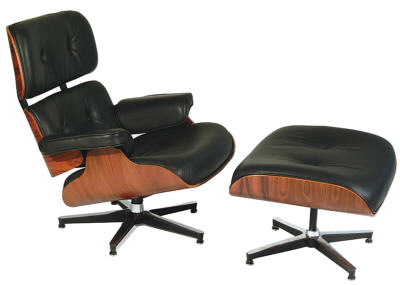
The Eames Lounge Chair and ottoman, officially titled Eames Lounge (670) and Ottoman (671), were released in 1956 after years of development by designers Charles and Ray Eames for the Herman Miller furniture company. It was the first chair the Eameses designed for a high-end market. These furnishings are made of molded plywood and leather. Examples of these furnishings are part of the permanent collection of New York's Museum of Modern Art.
Design
The Eameses focused first on usability in their designs. In addition to the style, the Eames Lounge Chair is very comfortable, a combination not always found in high design. The chair has become iconic with Modern style design although when it was first made Ray Eames remarked in a letter to Charles that the chair looked "comfortable and un-designy". Charles's vision was for a chair with "the warm, receptive look of a well-used first baseman's mitt." The chair is composed of three curved plywood shells. In modern production the shells are made up of seven thin layers of wood veneer glued together and shaped under heat and pressure. This differentiates the newer chairs from the "original" (vintage) chairs which used Brazilian rosewood veneers and were constructed of five layers of plywood. Also differentiating the very earliest sets from newer sets were rubber spacers between the aluminum spines and the wood panels first used in the earliest production models and then hard plastic washers used in later versions. In the earlier sets, the zipper around the cushions may have been brown or black as well, and in newer sets the zippers are black. The shells and the seat cushions are essentially the same shape: composed of two curved forms interlocking to form a solid mass. The chair back and headrest are identical in proportion, as are the seat and the Ottoman.
The Eameses constantly made use of new materials. The pair's first plywood chair—the Eames Lounge Chair Wood (LCW)—made use of a heavy rubber washer glued to the backrest of the chair and screwed to the lumbar support. These washers, which have come to be called 'shock mounts', allow the backrest to flex slightly. This technology was brought back in the 670 Lounge chair. The backrest and headrest are screwed together by a pair of aluminum supports. This unit is suspended on the seat via two connection points in the armrests. The armrests are screwed to shock mounts on the interior of the backrest shell, allowing the backrest and headrest to flex when the chair is in use. This is part of the chair's unusual design, as well as its weakest link. The rubber washers are solidly glued to the plywood shells, but have been known to tear free when excessive weight is applied, or when the rubber becomes old and brittle.
Other creative uses of materials include the seat cushions - which eschew standard stapled or nailed upholstery. Instead the cushions are sewn with a zipper around the outer edge that connects them to a stiff plastic backing. The backing affixes to the plywood shells with a series of hidden clips and rings. This design, along with the hidden shock mounts in the armrest allow the outside veneer of the chair to be unmarred by screws or bolts. The chair has a low seat which is permanently fixed at a recline. The seat of the chair swivels on a cast aluminum base, with glides that are threaded so that the chair may remain level.
History
The Eames Lounge Chair first appeared on the Arlene Francis 'Home" show broadcast on the NBC television network in the USA in 1956. Immediately following the début Herman Miller launched an advertising campaign that highlighted the versatility of the chair. Print ads depicted the 670 in a Victorian parlor, occupied by a grandmother shelling peas on the front porch of an American Gothic style house, and in the middle of a sunny field of hay. One notable advertisement was produced by the Eameses for Herman Miller warning consumers against imitations and knockoffs[citation needed]. It has also featured frequently in Frasier as a piece of furniture in the title character's apartment about which in the final series Martin Crane remarks that he finds it comfortable and hints that he may not have needed his recliner after all.
Since its introduction, the chair has been in continuous production by Herman Miller in America. Later, Vitra (in cooperation with the German furniture company Fritz Becker KG) began producing the chair for the European market. Immediately following its release other furniture companies began to copy the chair's design. Some made direct copies, others were merely 'influenced' by the design. Most notably the former Plycraft Company issued dozens of chairs that were direct copies of or in-the-style-of the Eames 670. Later Chinese and European companies began making direct copies. However, Herman Miller and Vitra remain the only two companies to produce these chairs with the Eames name attached.
In 2006, to commemorate the 50th anniversary of the chair, Herman Miller released models using a sustainable Palisander rosewood veneer.
Market
New
The Eames Lounge Chair is a classic design that has been in production continuously since its creation. The chair with Ottoman retails for US$4,500 or more in the US, depending on the selection of veneer and leather (leathers by Edelman, recently offered by Herman Miller, increase the price). In Europe, Vitra's versions are considerably more expensive (around $9,000 for the classic black leather Palisander).
Used
This section needs additional citations for verification. (October 2011)
There is a flourishing market for used Eames chairs. Some collectors are willing to pay high prices for earlier chairs made with Brazilian rosewood veneer, which is no longer available due to a worldwide embargo since 1992. (Brazilian rosewood — Dalbergia nigra — is listed on Appendix I of the CITES treaty as a highly endangered species.) Prices for original rosewood chairs have reached as much as US$7,000 in auction.





